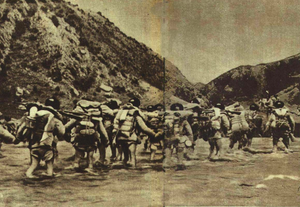| Battle of Chamdo | |||||||||
|---|---|---|---|---|---|---|---|---|---|
| Part of the Annexation of Tibet by the People's Republic of China and the Cold War | |||||||||
 PLA troops crossing the Mekong River prior to the battle. | |||||||||
| |||||||||
| Belligerents | |||||||||
|
|
| ||||||||
| Commanders and leaders | |||||||||
|
|
| ||||||||
| Strength | |||||||||
| Tibetan Army: 8,500[3] | People's Liberation Army: 40,000[4][5] | ||||||||
| Casualties and losses | |||||||||
|
180 killed or wounded[6][7][8] 3,341 killed, wounded, surrendered, captured, or defected (Chinese estimate)[2] | 114 killed or wounded[6] | ||||||||
The Battle of Chamdo (or Qamdo; Chinese: 昌都战役) occurred from 6 to 24 October 1950.[9][10] It was a military campaign by the People's Republic of China (PRC) to take the Chamdo Region from a de facto independent Tibetan state.[11][12][13][14] The campaign resulted in the capture of Chamdo and the annexation of Tibet by the People's Republic of China.
- ^ Mackerras, Colin. Yorke, Amanda. The Cambridge Handbook of Contemporary China. [1991]. Cambridge University Press. ISBN 0-521-38755-8. p. 100.
- ^ a b Goldstein, Melvyn C. (1991). A history of modern Tibet, 1913–1951, the demise of the lamaist state. University of California Press. p. 639.
- ^ Freedom in Exile: The Autobiography of the Dalai Lama, 14th Dalai Lama, London: Little, Brown and Co, 1990 ISBN 0-349-10462-X
- ^ Laird 2006 p. 301.
- ^ Shakya 1999, p. 43
- ^ a b Jiawei Wang et Nima Gyaincain, The historical Status of China's Tibet, China Intercontinental Press, 1997, p. 209 (see also The Local Government of Tibet Refused Peace Talks and the PLA Was Forced to Fight the Qamdo Battle, china.com.cn): "The Qamdo battle thus came to a victorious end on 24 October, with 114 PLA soldiers and 180 Tibetan troops killed or wounded."
- ^ Shakya 1999, p. 45. Shakya also quotes PRC sources reporting 5738 enemy troops "liquidated" and over 5700 "destroyed". Shakya does not provide an estimate of PRC casualties.
- ^ Feigon 1996, p. 144.
- ^ "Chinese Reds Promise the 'Liberation' of Tibet". The New York Times. 3 September 1949.
- ^ NOTE: The exiled Tibetan government in India calls The battle the "...invasion of Tibet by the People's Liberation Army of China," see Tibet: Proving Truth From Facts. The Status of Tibet: "At the time of its invasion by troops of the People's Liberation Army of China in 1949, Tibet was an independent state in fact and by law."
- ^ Tsering Shakya, Dragon in The Land of Snows: The History of Modern Tibet since 1947, Random House, 2012, Google e-book: "Tibet had never received de jure recognition from any state; in any case such recognition would be disputed not only by Beijing but also by the nationalist regime in Taiwan.
- ^ Stephanie Roemer, The Tibetan government-in-exile: politics at large, p. 32: "the Tibetans signed the so-called 'Seventeen Point Agreement', where they officially acknowledged the Chinese intentions to liberate Tibet, which meant the end of Tibet's de-facto independence."
- ^ John Kenneth Knaus, Orphans of the Cold War: America and the Tibetan struggle for survival[permanent dead link], p. 84 : The seventeen points of the agreement ended the de facto independence of Tibet.
- ^ Shakya 1999 pp. 28–32.